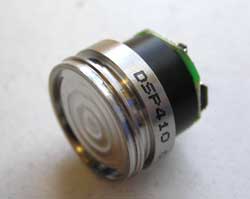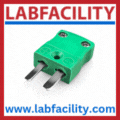
Posted to News on 5th Jan 2011, 07:26
Overcoming problems with silicon oil-filled pressure sensors
Sam Drury, Sales & Marketing Director at Impress Sensors & Systems, explains how the latest generation of pressure sensors overcomes the problems traditionally encountered with silicon oil-filled pressure sensors.

Historically, oil-filled pressure sensors that use silicon sensing elements have suffered in terms of their measurement performance and reliability due to a number of different factors. However, the latest versions now coming onto the market benefit from much-improved mechanical designs and are therefore able to overcome these drawbacks.
Most silicon pressure sensors are of the media-isolated type, ie they operate by using an isolated diaphragm. When measuring pressures, this diaphragm flexes and transfers the pressure via the oil onto a silicon chip. Compared to the latest sensor designs, traditional oil-filled, isolated-diaphragm silicon pressure sensors used a much higher volume of oil. While the cost of this oil is generally not an issue for users, the effects this oil has on the overall performance and thermal stability of the sensor is a critical design factor.
With traditional designs, air often penetrates the housing and becomes trapped within the oil, which can cause problems. As the sensor's operating temperature fluctuates, the physical properties of the oil change as the air within it expands or contracts, which leads to measurement errors. Over time, as the sensor becomes less airtight, more air enters the chamber and the problem worsens.
Less oil, better sealing
In order to solve these issues, the latest silicon pressure sensors use much-improved mechanically-sealed designs, which use only a fraction of the volume of oil compared to previous versions. This means that even if any air does get through to the oil, there is less oil and so the effects of temperature fluctuations on the oil are much less, which results in more reliable measurement performance and improved thermal stability. The effects are not completely eliminated but are greatly reduced compared to conventional versions. This means the latest sensors with improved mechanical sealing are now suitable for use in vacuum conditions.
Higher overpressures are also now possible. Typically, the latest silicon pressure sensors offer five times overpressure when operating at 1bar and above, which is much higher than conventional devices currently, therefore offering customers added security that the sensors will last even in an over-pressure state on their system. Similarly, for pressure ranges below 1bar, the latest sensors typically provide 10 times overpressure, therefore protecting the sensitive low-range diaphragms.
Higher accuracy
Accuracy is also improved to less than +/-0.1 per cent, which compares very favourably with traditional sensors. There are similar improvements in resolution, repeatability and thermal stability of the sensor.
Oil-filled silicon pressure sensors with an all-stainless steel construction can also be used in food and beverage processing. The latest sensors operate with food-grade oils and, due to their improved sealing, are resistant to frequent washdowns, chemicals and other cleaning detergents.
In the past, oil-filled silicon pressure sensors have suffered from orientation issues. For example, if a sensor is factory calibrated to 4mA in the horizontal position, but is then mounted at an angle or becomes slightly offset when installed, the changes to the physical properties of the oil (due to gravitational effects) may affect the sensor's measurement performance. The latest versions, which use significantly less oil, do not suffer to the same extent and the effects of gravity on the oil is greatly reduced.
Advantages of silicon pressure sensors
There are many reasons why users select silicon pressure sensors over alternative pressure sensing technologies. Here are some of the technical advantages:
Perfect elasticity
With silicon pressure sensors, the base diaphragm is typically made from n type mono-crystalline layer silicon, which is 100 per cent elastic up to its breaking point. This is what makes silicon an excellent material to use for the sensing diaphragm.
Low hysteresis
The combination of a high-elasticity material and almost perfectly bonded and integrated strain gauges produces a structure that has very little hysteresis. This ensures that pressure readings are precise, regardless of the direction of changing pressure.
Repeatability
Strain gauges are key elements for converting pressure into electrical signals. As these gauges are chemically altered areas of a uniform piece of material, they will deform almost perfectly (without lag or separation) with the stresses of the diaphragm. This means that the repeatability of pressure measurements is excellent over numerous pressure cycles (ie the sensor does not suffer from fatigue).
High gauge factors
High levels of voltage drop can be achieved across semiconductor strain gauges for a given pressure change, which means that better use can be made of analogue-to-digital resolution and improving signal-to-noise ratios.
Compact and lightweight
Silicon chip and silicon piezoresistive elements are manufactured using a combination of chemical etching, micro-machining, doping and masking, which creates mechanical structures with microelectronic components, enabling the production of miniature sensing elements. As the sensing diaphragm is often the limiting factor that controls the diameter of the finished sensor design, a more compact sensing element will help the engineer design a more compact, lightweight pressure sensor.
Acceleration
The compactness and reduced weight of the silicon sensing elements means that they are less susceptible to acceleration forces. These sensors are therefore preferred for use in applications where there are high 'g' forces, high vibration or impact shocks.
Stability
Semiconductor strain gauges are not bonded, printed or electroplated to the surface of the sensing diaphragm, but are a chemically changed part of the same material. Over time, strain gauge bonds can deteriorate or change with pressure and temperature cycling, which leads to instabilities in sensor performance.
High overpressures
The higher gauge factors of semiconductor strain gauges compared to other types of strain gauge make it possible to use stiffer diaphragms for a given pressure range to allow a high overpressure rating to be specified, without compromising too much sensitivity. The high elasticity of silicon also makes it possible to strain silicon further than other less elastic diaphragm materials.
Dynamic response
Due to the high sensitivity of semiconductor strain gauges, the ratio of thickness to cross-sectional area is relatively high for a sensing diaphragm. Also, the small size results in a very high natural frequency. This, combined with the elasticity and integral strain gauges, makes silicon strain gauge diaphragms highly responsive to rapid changes in pressure.
Follow the link for more information about the latest generation of silicon oil-filled pressure sensors available from Impress Sensors & Systems.
Regency House
22-25 Kingsclere Park
RG20 4SW
UNITED KINGDOM
+44 (0)1635 291600




